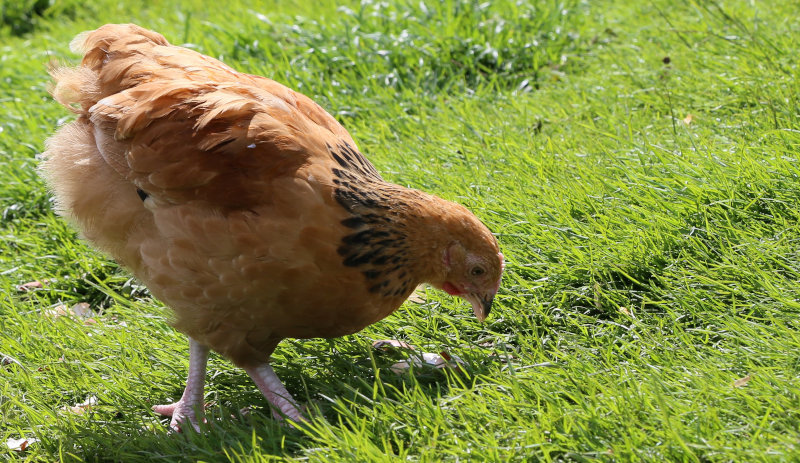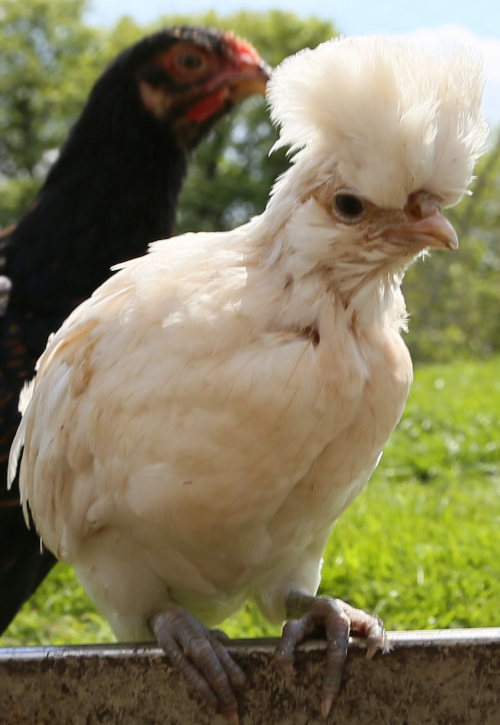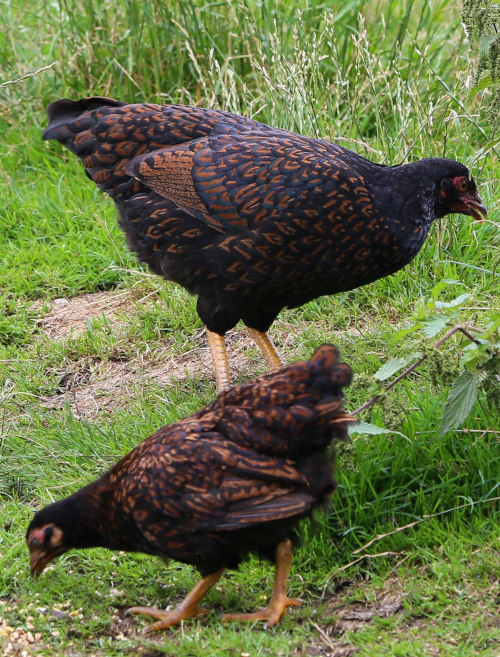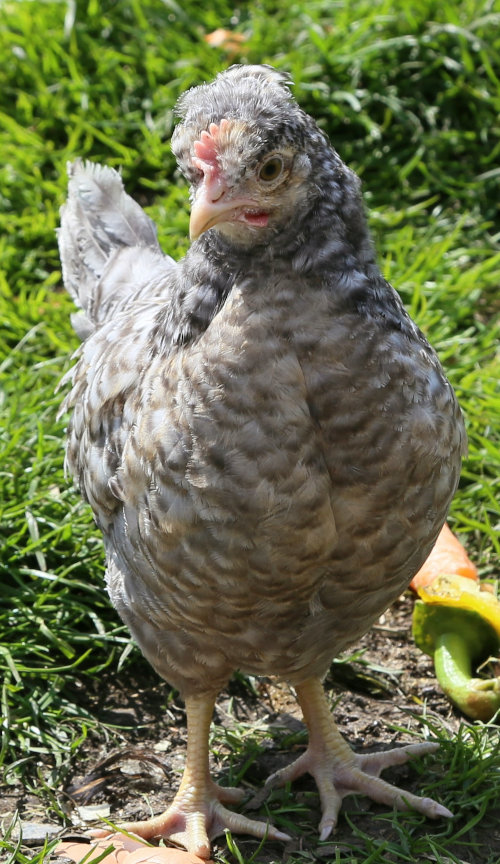Cold tolerance of young chickens and growers

It seems that there is an often stated formula that when brooding chickens, the environment can get 3 degrees Celsius or 5 degrees Fahrenheit colder for every week older they are but this is not always the case.
Chickens raised during the summer are often beginning to mature just as the days shorten and there is much less time for growing and eating.
Silkies are slow growers and even when they are fully grown at around 30 weeks I think they still need to fill out and bulk up a bit and should not be subject to really low temperatures.
Below: Young bantams need longer under heat.

Slow or Frizzle feathering breeds will also need longer in the brooder.
With adult chickens a full crop will sustain them for up to 6 hours overnight but with younger birds long night without food may begin to become a problem, especially if you live quite far north where the days are short.
The coldest it has been here in North Yorkshire in recent years is -17.9 C or about 0 F and my Silkies were fine with that (I have a big poly-tunnel that is free of snow and ice). That included that year's youngsters which would have been around 30/32 weeks old.
Those youngsters didn't grow much over the winter and took a few weeks to start laying in the new year, this is one of the effects of the short days.
I have found that below freezing is sometimes easier as it's dry, the real danger is the damp with the cold.
Young chickens or growers are more susceptible to cold because:
- They are small.
- Growers are constantly moulting and changing their feathers.
- They haven't put down any insulating fat that comes with age.
- The digestive system and crop is not yet full size.
- Young chickens panic more easily.
Can young chickens handle cold weather?
As a species the chicken is more tolerant to cold than hot conditions but it is often not the cold that is the issue.
I had a Silkie cross hatch some chicks in February a few years ago when there was 2 foot of snow on the ground. Because she and the chicks were well fed and watered they all survived just fine.
Chickens can deal with surprisingly low temperatures if they are dry and well fed. Well fed is a problem if you have long nights like I do here in the North of England as they don't have enough eating time. The food in the crop last a maximum of 4 hours at that stage of life.
I would say that if young chickens are indoors in a dry shed with no drafts and supplemental lighting they could tolerate 0 C / 32 F from 12 weeks of age. They would need to be gradually acclimated too those conditions and I suspect that your weather like ours is unpredictable to some extent.
Below: This image shows the difference between growers at 8 and 12 weeks.

At 9 weeks I would not expose them to temperatures lower than 15 C but again that depends on conditions.
It also depends on where you are currently keeping them. A single layer wooden shed is going to be more of a problem than a garage or brick built structure with damp proofing.
What temperature is too cold for young chickens?
Below 35 C or 95 F is too cold for day old chicks. Young chickens can tolerate 3 C or 5 F less for every week older they get. Young chickens that are too cold will peep loudly and huddle together.
Whatever temperature you set in your brooder it should always have a warmer spot and cooler areas so as the young birds can find their own temperature.
Chickens are controlled by day length and young birds will need at least 14 hours of light a day.
Temperatures in the table below are a guide to how much heat chicks and growers need as they grow.
You will need a thermometer to check temperatures, above 47 C or 117 F will kill chicks in minutes.
Minimum temperature requirements for growing chickens:
- Day old chicks - 35 C (95 F) to 38 C (100 F).
- 1 week old chicks - 32 C (90 F) to 35 C (95 F)
- 2 week old chicks - 28 C (85 F) to 32 C (90 F)
- 3 week old chicks - 25 C (77 F) to 32 C (85 F)
- 4 week old chicks - 22 C (71 F) to 25 C (77 F)
- 5 week old chicks - 19 C (66 F) to 22 C (71 F)
- 6 week old chicks - 16 C (60 F) to 19 C (66 F)
- 8 week old growers - 13 C (55 F) to 16 C (60 F)
- 10 week old growers - 10 C (50 F) to 13 C (55 F)
- 12 week old growers - 0 C (32 F) to 10 C (50 F)
- 16 week old growers - 5 C (23 F) to 0 C (32 F)
- 20 week POL - 18 C (0 F) to -5 C (23 F)
The chart gives minimum temperatures assumes birds are dry and indoors.
Periodic exposure to cold is good for young and growing chickens as it speeds up feathering.
You should never try to aim for a blanket temperature in the brooder and for more than 25 chicks you will need a second heat source to avoid crowding and piling.
At what age can chicks live outside?
Chicks without a heat lamp or mother hen to keep them warm will need to be at least 6 weeks old and fully feathered before they are moved outside. 4 or 5 weeks old is too young for baby chicks to live outside.
Small breeds of chicken or slow feathering types will likely need to be 8 or 10 weeks old before they live outdoors.
Below: This 12 week old cream crested legbar grower is fine outside in summer but not in the fall or winter.

The dryer the conditions the better and in cold and wet weather the move outdoors will need to be delayed.
How do you keep growing chickens warm?
If I had 9 week old chicks in winter I would still have them with a heat source and extra lighting. I can buy seedling heating pads which I put in layer of sand to create a warm patch of about 20 F / 7 C above ambient.
You can keep growing chickens warm with:
- Seed tray or reptile heating pads.
- Incandescent light bulbs.
- Heat lamps.
- Gas or electric brooders.
Whatever you decide to do, watch them like a hawk for a few hours and then closely for a few days to see how they get on, they will let you know if they are cold.
Below: Day old chicks need at least 35 C in a brooder to be comfortable.
I think growers should have learned how to roost properly for the night before they are put in with the rest of the flock as this is a big part of them staying warm. If might surprise you but chickens roosting is better for them and they often shuffle together to share warmth.
What happens if chickens get too cold?
Chickens can freeze to death if they get too cold and it happens quickly with growing birds. Cold chickens tend to pile in corners to keep warm and smother each other to death.
Cold chickens can become unthrifty and a cold shock to the system can stunt their growth and development. There is also always the risk of frostbite to combs and feet. I once had 2 young cockerels spend the night outside and I ended up having to dispatch them as the were frozen to their perch overnight.
At what age can chickens survive without a heat lamp?
Chickens or growers can survive from 8 weeks old without a heat lamp. Bantams and true bantams should be given a week or two more as should Frizzles, Silkies and naked neck chickens.
If there is bad or cold weather conditions then consider keeping them in the brooder for a week or two extra as well.
